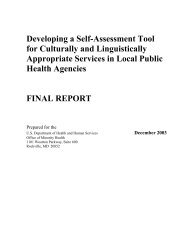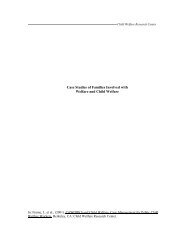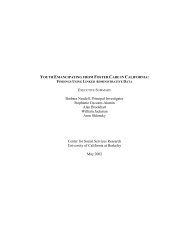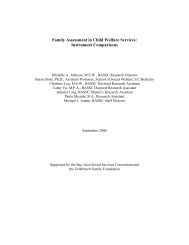Healthy Aging for Older Adults in the US-Satariano - Center for ...
Healthy Aging for Older Adults in the US-Satariano - Center for ...
Healthy Aging for Older Adults in the US-Satariano - Center for ...
You also want an ePaper? Increase the reach of your titles
YUMPU automatically turns print PDFs into web optimized ePapers that Google loves.
<strong>Healthy</strong> <strong>Ag<strong>in</strong>g</strong> <strong>for</strong> <strong>Older</strong> <strong>Adults</strong> <strong>in</strong> <strong>the</strong> United StatesWilliam A. <strong>Satariano</strong>, Ph.D., MPHSchool of Public HealthUniversity of Cali<strong>for</strong>nia, Berkeley
Global <strong>Ag<strong>in</strong>g</strong>The human population is ag<strong>in</strong>g.Percent of <strong>the</strong> Population Aged 65+ by Region, 2000Europe North America Asia14.0 12.6 5.9
Global <strong>Ag<strong>in</strong>g</strong>The human population is ag<strong>in</strong>g.Percent of <strong>the</strong> Population Aged 65+ by Region, 2030Europe North America Asia23.1 20.3 11.9
Global <strong>Ag<strong>in</strong>g</strong>The human population is ag<strong>in</strong>g.Percent of <strong>the</strong> Population Aged 65+ by Region, 2050Europe North America Asia28.6 20.7 18.0
Implications of <strong>Ag<strong>in</strong>g</strong> SocietiesDoes ag<strong>in</strong>g represent a global problem?Is it possible to identify and enhancepositive aspects of ag<strong>in</strong>g?What is healthy ag<strong>in</strong>g? Is it possible?
AimsDef<strong>in</strong>ition of <strong>Healthy</strong> <strong>Ag<strong>in</strong>g</strong>Implications <strong>for</strong> Research and PracticeNew DirectionsConsider <strong>the</strong>se issues with<strong>in</strong> <strong>the</strong> U.S.context
Important QuestionsWhat is healthy ag<strong>in</strong>g?Whom do we ask?
Successful <strong>Ag<strong>in</strong>g</strong>Low risk of disease and disease-relateddisability.High mental and physical function.Active engagement with life.Rowe J, Kahn R. Human ag<strong>in</strong>g: Usual and successful. Science1987;237:143-149.
Related ConceptsChronological Age vs. Functional AgeWHO Def<strong>in</strong>ition of Health. Not just <strong>the</strong> absenceof disease. Complete state of physical, mental,and social well-be<strong>in</strong>g.
EpidemiologyBased on <strong>the</strong> premise that health outcomes arenot distributed randomly <strong>in</strong> <strong>the</strong> population.Describe and expla<strong>in</strong> patterns of healthoutcomes <strong>in</strong> populations.
Conceptualization and Measurement ofSuccessful <strong>Ag<strong>in</strong>g</strong>Concept assumes some distribution of healthand function<strong>in</strong>g <strong>in</strong> older populations.Concept assumes that “successful ag<strong>in</strong>g” isreflected at <strong>the</strong> upper end of <strong>the</strong> distribution.– Top 20%– Top 33%Concept assumes that <strong>the</strong> components ofsuccessful ag<strong>in</strong>g are clustered.
Measurement of Successful <strong>Ag<strong>in</strong>g</strong>Top 20% of a summated score based on <strong>the</strong>follow<strong>in</strong>g:– ADL– Physical function<strong>in</strong>g (Rosow-Breslau & Nagi items)– IADL– Physical exerciseGuralnik J, Kaplan G. Predictors of healthy ag<strong>in</strong>g: Prospective evidencefrom <strong>the</strong> Alameda County Study. American Journal of Public Health1989;79:703-708.
QuestionsWhat about older people with multiple conditionsand limitations who rema<strong>in</strong> engaged <strong>in</strong> everydaylife?Among older people diagnosed and treated <strong>for</strong>specific conditions, why do some survive longerand better than o<strong>the</strong>rs?Is it possible <strong>for</strong> older adults with multiple healthconditions and limitations to age healthfully?
SalutogenesisThe causes of health.Not only those people at <strong>the</strong> upper end of <strong>the</strong>health-disease spectrum, but also those who areable to ma<strong>in</strong>ta<strong>in</strong> <strong>the</strong>ir health <strong>in</strong> spite of a highriskprofile.______________Antonovsky A. Health, Stress, and Cop<strong>in</strong>g. San Francisco: Jossey-Bass, 1979
<strong>Healthy</strong> <strong>Ag<strong>in</strong>g</strong>: An Expanded Def<strong>in</strong>ition?Is healthy ag<strong>in</strong>g more than <strong>in</strong>dividual capacity,number and severity of health conditions, andlevels of activity?Does this suggest that healthy ag<strong>in</strong>g may bemore prevalent than orig<strong>in</strong>ally thought?Does this expand our notion of <strong>the</strong> causes ofhealthy ag<strong>in</strong>g as well as <strong>the</strong> types of programsand policies to enhance healthy ag<strong>in</strong>g?
CDC <strong>Healthy</strong> <strong>Ag<strong>in</strong>g</strong> Network<strong>Healthy</strong> ag<strong>in</strong>g is <strong>the</strong> development and ma<strong>in</strong>tenance of optimalphysical, mental and social well-be<strong>in</strong>g and function <strong>in</strong> older adults.It is most likely to be achieved when physical environments andcommunities are safe, and support <strong>the</strong> adoption and ma<strong>in</strong>tenanceby <strong>in</strong>dividuals of attitudes and behaviors known to promote healthand well-be<strong>in</strong>g;And by <strong>the</strong> effective use of health services and community programsto prevent or m<strong>in</strong>imize <strong>the</strong> impact of acute and chronic disease onfunction.
Implications <strong>for</strong> Research and PracticeEpidemiology of <strong>Ag<strong>in</strong>g</strong>– Patterns of health and well-be<strong>in</strong>g vary by– Socioeconomic status– Liv<strong>in</strong>g arrangements– Past and current health behaviors– Place
Supportive EnvironmentIs it possible to preserve and promote healthyag<strong>in</strong>g among older adults with reduced capacitythrough environmental design?
Promotion of walk<strong>in</strong>gis an efficient andeffective public healthstrategy to promoteand preserve healthand function<strong>in</strong>g <strong>in</strong>ag<strong>in</strong>g populations.Background
How best to promotewalk<strong>in</strong>g <strong>in</strong> olderpopulations?Background
ObjectiveExam<strong>in</strong>e to what extent functional capacity anda diverse range of neighborhood elements areassociated with level of walk<strong>in</strong>g among olderadults.
ObjectiveExam<strong>in</strong>e to what extent elements of <strong>the</strong>neighborhood environment moderate <strong>the</strong>association between reduced functional capacityand sedentary behavior among older adults.
ImplicationsBetter understand<strong>in</strong>g of <strong>the</strong> reasons why somewalk and o<strong>the</strong>rs do not.Environmental design may contribute to <strong>the</strong>cont<strong>in</strong>uation of walk<strong>in</strong>g, especially among olderpeople with reduced lower-body function.
Areas that encourage walk<strong>in</strong>g
Areas that discourage walk<strong>in</strong>g
Neighborhood EnvironmentPotential <strong>for</strong> affect<strong>in</strong>g large numbers ofpeople now and <strong>in</strong> <strong>the</strong> future (“UpstreamPerspective”)Central to a consideration of ag<strong>in</strong>g.
Lawton Environmental Theory of <strong>Ag<strong>in</strong>g</strong>The effects of <strong>the</strong>environment becomemore pronouncedwith age-relateddecl<strong>in</strong>es <strong>in</strong> health andfunction<strong>in</strong>g.Person-EnvironmentFit Model
ExamplesClarke P, George LK. The role of <strong>the</strong> builtenvironment <strong>in</strong> <strong>the</strong> disablement process. Am JPublic Health 2005;95(11):1933-1939.– Among older people with lower extremity function,those resid<strong>in</strong>g <strong>in</strong> areas with more land-use diversitywere more likely to be <strong>in</strong>dependent <strong>in</strong> ADL and IADLthan older people with <strong>the</strong> same lower extremityfunction but resid<strong>in</strong>g <strong>in</strong> areas with less land-usediversity.
FIGURE 1-- Effect of hous<strong>in</strong>g density and land-use diversity on (a) ADL and (b) IADL disabilityby lower extremity functional limitationsClarke, P. et al. Am J Public Health 2005;95:1933-1939Copyright ©2005 American Public Health Association
ResultsElements of <strong>the</strong> neighborhoodenvironment improve activity among olderadults with reduced capacity.Suggests that environmental design mayenhance activity among adults with agerelatedlimitations.
U.S. Policy implicationsThe ag<strong>in</strong>g population <strong>in</strong> <strong>the</strong> U.S. isbecom<strong>in</strong>g more racially and ethnicallydiverse.– Percent of non-Hispanic white seniors will decl<strong>in</strong>efrom 83.5% to 64.2% between 2000 and 2050.
U.S. Policy implicationsRegional and geographic diversity.Place-based programs that take <strong>the</strong>se factors<strong>in</strong>to account may succeed.
Environmental InterventionsEnvironmental Modifications (e.g., land-usediversity and density, sidewalks)Environmental L<strong>in</strong>kage (e.g., “walk<strong>in</strong>g maps”,technological <strong>in</strong>novations)
New DirectionsMultidiscipl<strong>in</strong>ary research designs.Multidiscipl<strong>in</strong>ary research <strong>in</strong>frastructureFund<strong>in</strong>g ResourcesTra<strong>in</strong><strong>in</strong>g Programs
Return to our panel of experts
Is <strong>Healthy</strong> <strong>Ag<strong>in</strong>g</strong> Really Possible?Yes, and probably <strong>in</strong> all of those cases.<strong>Healthy</strong> ag<strong>in</strong>g is not one th<strong>in</strong>g.Look beyond capacity and consider factors thatserve to ei<strong>the</strong>r impede or enhance health,function<strong>in</strong>g, and engagement <strong>in</strong> everyday life.
















